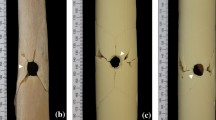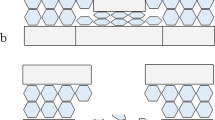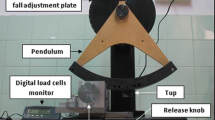Abstract
Knowledge of material behaviour under impact is of key importance to understand ballistic impact events on tissue. Bone—with its complex underlying microstructure—is no exception; the microstructural network in bone is not only crucial to its integrity, but also provides a pathway for energy dispersion upon impact (Piekarski in J Appl Phys 41:215–225, 1970). Synbone®, a Swiss-made polyurethane bone simulant, has been considered as a potential bone analogue, particularly for cranial structures (Smith et al. in Leg Med 17(5):427–435, 2015; Riva et al. in Forensic Sci Int 294: 150–159, 2019). This study focused on long bone models and cylinders available from Synbone®, with the aim of determining their efficacy for use in ballistic testing and recreation. Comparisons were made between porcine bone and multiple Synbone® models regarding projectile energy loss and damaged surface area using high-speed video and high-resolution photography. CT and reverse ballistics techniques were also used as diagnostic tools. A significant correlation was made between real bone and Synbone®’s ballistic cylinders in all aspects of this study; however, it was observed that osteoporotic cylinders and anatomical models differ significantly in their reaction to impact. Consequently, the use of Synbone® as a ballistic target simulant—particularly when legal or practical accuracy is essential—will need to be treated carefully, giving due attention to these limitations.












Similar content being viewed by others
References
Berryman H, Lanfear A, Shriley N (2012) The biomechanics of gunshot trauma to bone: research considerations within the present judicial climate. In: Dirkmaat D (ed) A companion to forensic anthropology. Blackwell Publishing Ltd, West Sussex, pp 390–399
Rho J, Kuhn-Spearing L, Zioupos P (1998) Mechanical properties and the hierarchal structure of bone. Mech Eng Phys 20:92–102
Piekarski K (1970) Fracture of bone. J Appl Phys 41:215–225
DiMaio V (2016) Gunshot wounds; practical aspects of firearms, ballistics and forensic techniques, 3rd edn. CRC Press, Boca Raton
Berryman H, Smith O, Symes S (2007) Diameter of cranial gunshot wounds as a function of bullet calibre. J Forensic Sci 52(3):751–754
Ross A (1996) Calibre estimation from cranial entrance defect measurements. J Forensic Sci 41:629–633
Paschall A, Ross A (2017) Bone mineral density and wounding capacity of handguns; implications for estimation of caliber. Int J Leg Med 45:161–166
Berryman H, Gunther W (2000) Keyhole defect production in tubular bone. J Forensic Sci 45(2):123–131
Henwood B, Oost T, Fairgrieve S (2019) Bullet caliber and type categorization from gunshot wounds in Sus scrofa (Linnaeus) long bone. J Forensic Sci. https://doi.org/10.1111/1556-4029.14004
Cohen H, Kugel C, May H, Medlej B, Stein D, Slon V, Hershkovitz I, Brosh T (2016) The impact velocity and bone fracture pattern. Forensic Perspect 266:54–62
Kneubuehl B, Coupland R, Rothschild M, Thali M (2008) Wound ballistics. Springer, Berlin
Smith M, James S, Pover T, Ball N, Barnetson V, Foster B, Guy C, Rickman J, Walton V (2015) Fantastic plastic? Experimental evaluation of polyurethane bone substitutes as proxies for human bone in trauma simulations. Leg Med 17(5):427–435
Synbone® (2019) Portfolio for ballistic testing. https://www.synbone.com/app/uploads/2017/01/1484314977-b61bc01138a7d03c233f8e8eec59462c.pdf. Accessed 13 Apr 2019
Fitzmaurice B (2014) On the properties and suitability of Synbone as a tissue simulant. M.Sc. dissertation, Cranfield University
Riva F, Lombardo P, Zech W, Jackowski C, Schyma C (2019) Individual synthetic head models in wound ballistics- a feasibility study based on real cases. Forensic Sci Int 294:150–159
Aerssens J, Boonen S, Lowet G, Dequeker J (1998) Interspecies differences in bone composition, density and quality: potential implications for in vivo bone research. Endocrinology 139(2):663–670
IBM SPSS Statistics for Windows (2015) version 23.0.0.2
Everett B, Shrondal A (2010) The Cambridge dictionary of statistics, vol 4. Cambridge University, Cambridge
Appleby-Thomas GJ, Jaansalu K, Hameed A, Painter J, Shackel J, Rowley J (2019) A comparison of ballistic behaviour of conventionally sintered and additively manufactured alumina. Def Technol. https://doi.org/10.1016/j.dt.2019.06.020
Acknowledgements
The work contained in this paper was completed within a Master of Science in Forensic Ballistics at Cranfield University by the primary author. The authors would like to express the deepest gratitude to Andy Roberts and Dave Miller for their work with the targets and gas guns, Fiona Brock for her work with the computed tomography and Christine Grey without whom this project would not have come to fruition and also to Rachael Hazael and John Rickman for their insight and support.
Author information
Authors and Affiliations
Corresponding author
Ethics declarations
Conflict of interest
The authors have no conflict of interest to declare.
Additional information
Publisher's Note
Springer Nature remains neutral with regard to jurisdictional claims in published maps and institutional affiliations.
Electronic supplementary material
Below is the link to the electronic supplementary material.
Rights and permissions
About this article
Cite this article
Henwood, B.J., Appleby-Thomas, G. The suitability of Synbone® as a tissue analogue in ballistic impacts. J Mater Sci 55, 3022–3033 (2020). https://doi.org/10.1007/s10853-019-04231-y
Received:
Accepted:
Published:
Issue Date:
DOI: https://doi.org/10.1007/s10853-019-04231-y




